 |
Natural History of the
Canary Islands – part 3
by Teresa Farino and John Muddeman
Forest Habitats of the Canaries
 Thermophilic Forest zone, La Gomera© Teresa Farino Thermophilic Forest zone, La Gomera© Teresa Farino
Thermophilic Forest
The thermophilic forest is essentially a transitional zone lying above the arid badlands, its upper margin grading into laurel forests on north-facing slopes and pines on the southern flanks of the islands. Ever since the Canaries were first colonized by man, this has been the most populated zone in the archipelago, much affected by centuries of felling, grazing and agriculture, such that little remains of the climax vegetation today, although enclaves persist on inaccessible sea cliffs and in some of the gorges, such as the Barranco del Infierno, on Tenerife.
Because temperatures are slightly lower and rainfall a little higher than in the Basal Zone, stands of endemic Canary Palms (Phoenix canariensis) and Canary Junipers (Juniperus turbinata ssp. canariensis) are able to grow here, accompanied by a range of fairly drought-tolerant shrubs such as Wild Olive (Olea cerasiformis), Maytenus canariensis, and the deciduous Pistacia atlantica.
-in-the-Barranco-de-Igueste-Tenerife.jpg) Dragon tree (Dracaena draco) in the Barranco de Igueste, Tenerife© Teresa FarinoThe Canary Palms have long been cultivated, particularly on La Gomera, where a syrup is prepared from the sap and the fronds are used for animal fodder. Together with Date Palms (Phoenix dactylifera), they have also been planted extensively for ornamental purposes, but truly wild populations are extremely rare today. Dragon tree (Dracaena draco) in the Barranco de Igueste, Tenerife© Teresa FarinoThe Canary Palms have long been cultivated, particularly on La Gomera, where a syrup is prepared from the sap and the fronds are used for animal fodder. Together with Date Palms (Phoenix dactylifera), they have also been planted extensively for ornamental purposes, but truly wild populations are extremely rare today.
Perhaps the most famous denizen of these warmth-loving forests, however, is the Dragon Tree (Dracaena draco), a Macaronesian endemic member of the Lily family (Liliaceae). Dragon Trees are much sought after for their dark red sap, colloquially known as 'dragon's blood', which is reputed to have medicinal and magical properties. As a result, only young trees survive in the wild, confined to inaccessible nooks and crannies in a few hot, humid, steep-sided barrancos on Tenerife, La Palma and Gran Canaria.
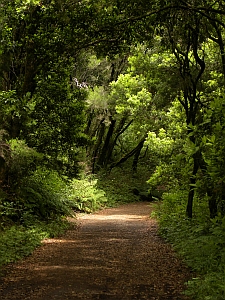 Laurisilva - Garajonay National Park, La Gomera© Teresa Farino It is however, commonly planted in parks and gardens, where it eventually develops into a graceful, umbrella-shaped tree, its single trunk topped by numerous forked branches, at the ends of which grow clusters of half-metre-long, sword-shaped leaves. Laurisilva - Garajonay National Park, La Gomera© Teresa Farino It is however, commonly planted in parks and gardens, where it eventually develops into a graceful, umbrella-shaped tree, its single trunk topped by numerous forked branches, at the ends of which grow clusters of half-metre-long, sword-shaped leaves.
Laurisilva
As the prevailing northerly winds encounter the abrupt peaks of the westernmost Canary Islands they are forced upwards, such that the air cools and water vapour condenses, creating a dense, persistent cloud layer between 500 and 1,200 m on the north-facing slopes. This humid, montane zone is occupied by the renowned laurel forests - known locally as laurisilva - of the archipelago. Wreathed in perpetual mist, these damp, shady woodlands represent some of the last remaining examples of the semi-tropical vegetation that dominated much of Europe during the Tertiary period, with exceptional stands preserved within the Garajonay National Park on La Gomera.
 Ixanthus viscosus© Teresa Farino Ixanthus viscosus© Teresa Farino
Among the trees of the laurisilva, adaptation to high levels of humidity has resulted in an overriding morphological stereotype, similar to that frequently encountered in the tropical forests of the world: tough, evergreen, glossy leaves with pronounced 'drip-tips', such that water runs off easily and doesn't accumulate to rot the foliage. As a result, it is hard to differentiate between the various tree species that make up the canopy, only four of which are in fact laurels (family Lauraceae): Laurus novocanariensis, Ocotea foetens, Persea indica and Apollonias barbujana. The other characteristic laurisilva trees belong to a wide range of families: Small-leaved and Large-leaved Hollies (Ilex canariensis and Ilex perado ssp. platyphylla), in the Aquifoliaceae, Prunus lusitanica ssp. hixa, in the Rosaceae, the strawberry-tree Arbutus canariensis (Ericaceae), the buckthorn Rhamnus glandulosa (Rhamnaceae), and Pleiomeris canariensis (a Canary endemic genus) and Heberdenia excelsa in the essentially tropical Myrsinaceae.
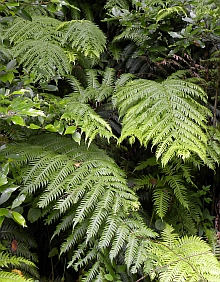 Woodwardia radicans© Teresa Farino Woodwardia radicans© Teresa Farino
In the most ancient of these woodlands, the branches of the trees are interlinked to such an extent that the canopy is continuous. As a result, the forest floor receives virtually no light at all, such that only a few extremely shade-tolerant plants can survive at ground level, for example, the orange-flowered foxglove relative Isoplexis canariensis and a tall member of the gentian family with large yellow flowers known as Ixanthus viscosus; another Canary endemic genus. Ferns too abound here, notably the spectacular Woodwardia radicans, whose two-metre fronds produce roots where their tips meet the ground, as well as Dryopteris oligodonta, Pteris incompleta and Diplazium caudatum.
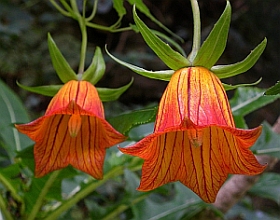 Canary Bellflower Canarina canariensis© Teresa Farino Canary Bellflower Canarina canariensis© Teresa Farino
Climbing plants such as the blue-flowered bindweed Convolvulus canariensis, the exquisite Canary Bellflower (Canarina canariensis) and the liliaceous lianes Smilax canariensis and Semele androgyna scramble through the understorey in order to get closer to the light, while epiphytic lichens, mosses and ferns - particularly Davallia canariensis - festoon the trunks of the trees, their water requirements satisfied by the constant mist.
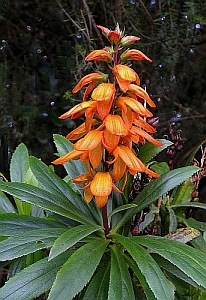 Isoplexis canariensis© Teresa Farino Isoplexis canariensis© Teresa Farino
Among the animal inhabitants of the laurisilva, the two endemic laurel pigeons undoubtedly take pride of place. Both Bolle's Pigeon and the Laurel Pigeon are confined to the islands of La Palma, El Hierro, La Gomera and Tenerife, where they feed almost exclusively on the fleshy fruits of the laurel forest trees. While the Laurel Pigeon tends to nest in crevices or small caves on rocky outcrops, usually just below the laurisilva zone, in the thermophilic woodlands, Bolle's Pigeon breeds only in the thickest, most mature laurel forests, constructing untidy platforms of sticks in the trees;
 Male Common Chaffinch Male Common Chaffinch
Fringilla coelebs canariensis© Teresa Farinoclutch size in both species is just a single egg.
Other noteworthy birds of these forests, though in most cases not exclusive to them, are the Canary Islands Chiffchaff (Phylloscopus canariensis), the various forms of the taxonomically confusing African Blue Tit (Cyanistes teneriffae) complex, and the various races (canariensis, palmae and ombriosa) of Common Chaffinch (Fringilla coelebs), all of which are also confined to the archipelago. The diminutive Canary Islands Kinglet, formerly considered a full species, has recently been demoted to a subspecies of Common Goldcrest (Regulus regulus teneriffae).
 Canary Pine (Pinus canariensis) forest, Roque Nublo, Gran Canaria© Teresa Farino Canary Pine (Pinus canariensis) forest, Roque Nublo, Gran Canaria© Teresa Farino
Canary Pine Forests
Above the sea of cloud that is such a feature of north-facing slopes, humidity is lower and temperatures decrease significantly, especially at night, despite the fact that the level of insolation is much higher. These fairly harsh conditions give rise to a Dry Montane Zone that extends from about 1,200 m to 2,000 m, while on southerly inclines, in the absence of the laurel forests, it may commence at just 700 m above sea level. The only native tree able to tolerate this marked diurnal temperature variation and paucity of soil water is the Canary Pine (Pinus canariensis), a species unique to the archipelago.
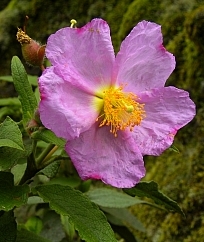 Cistus symphytifolius© Teresa Farino Cistus symphytifolius© Teresa Farino
As is the case with the laurisilva, Canary Pine forests are absent from the low-lying islands of Fuerteventura and Lanzarote, with the most extensive stands occurring on Tenerife, La Palma, El Hierro and Gran Canaria. The Canary Pine is blessed with an extensive root system that allows it to colonize even the poorest of soils, including lava flows and pyroclastic fall-out, although under favourable conditions these trees can grow to a staggering 50 m. It is also supremely adapted to forest fires, able to shoot from the base even after the tree has been completely destroyed, while the seeds germinate readily after such events. As pine needles decay extremely slowly,
-fortunata.jpg) Caterpillar of Calliteara (Macaronesia) fortunata© Teresa Farino the soil beneath the trees is very poor in nutrients, such that other plants find it difficult to grow here; among the most characteristic shrubs are the pink-flowered Cistus symphytifolius and the legume Chamaecytisus proliferus, distinguished by its white flowers, both of which grow only in the Canary Islands. Caterpillar of Calliteara (Macaronesia) fortunata© Teresa Farino the soil beneath the trees is very poor in nutrients, such that other plants find it difficult to grow here; among the most characteristic shrubs are the pink-flowered Cistus symphytifolius and the legume Chamaecytisus proliferus, distinguished by its white flowers, both of which grow only in the Canary Islands.
Not many species of insect find pine needles palatable, but caterpillars of the Canary endemic moth Calliteara (Macaronesia) fortunata (family Lymantriidae) are the exception to the rule, sometimes reaching plague proportions in the Canary Pine forests, while the larvae of the jewel beetle Buprestis bertholoti (family Buprestidae) and the bark-gnawing beetle Temnochila pini (family Ostomidae) feed in dead pine trees.
Two endemic races of Great Spotted Woodpecker (Dendrocopos major) - thanneri from Gran Canaria
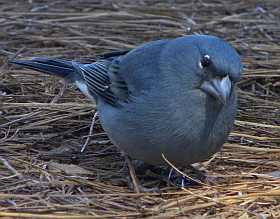 Male Blue Chaffinch Fringilla teydea teydea© Teresa Farinoand canariensis on Tenerife - have their strongholds in the Canary pine forests, where night-flying invertebrates provide food for the Canary Big-eared Bat, which is also confined to the archipelago. The best-known denizen of this habitat, however, is the Canary endemic Blue Chaffinch, the males of which are stunning slate-blue birds. They are often seen in small groups in the more open pine woodlands of Tenerife's Corona Forestal Natural Park, foraging for the pine kernels that make up a large part of their diet. Male Blue Chaffinch Fringilla teydea teydea© Teresa Farinoand canariensis on Tenerife - have their strongholds in the Canary pine forests, where night-flying invertebrates provide food for the Canary Big-eared Bat, which is also confined to the archipelago. The best-known denizen of this habitat, however, is the Canary endemic Blue Chaffinch, the males of which are stunning slate-blue birds. They are often seen in small groups in the more open pine woodlands of Tenerife's Corona Forestal Natural Park, foraging for the pine kernels that make up a large part of their diet.
|